
Vue des Îsles de L'Amirauté
Piron del. Dien scripsit. Imprimée chez Dien.
[Paris: H.J.Jansen, 1800.]
Engraving. 310 x 440mm (12¼ x 17¼").
View in the Admiralty Islands, in the Manus Province of Papua New Guinea, with locals spear-fishing from canoes. In 1788 Jean-Francois de Galaup, comte de La Pérouse set sail from Botany Bay and was never seen again. Despite the upheaval of the French Revolution the National Assembly was moved to send an expedition in search of their lost hero, 1791-3, under Chevalier Bruni d'Entrecasteaux. Despite finding no trace of La Perouse, losing its commander and many crew to scurvy, and finally splitting between royalist and republican factions, the expedition was judged a success because of the important observations made by the expedition's scientists, especially in Australia. This account, compiled by the expedition's botanist, Jacques Julien Houtou de Labillardière, was published as 'Relation du voyage à la recherche de La Pérouse', with natural history plates by Redouté and Audebert. The work even has its own abbreviation in botantical literature, 'Voy.Rech.Perouse'. Ex Collection Norman Blackburn.
[Ref: 18696] £550.00
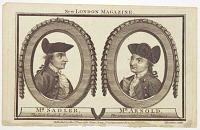
New London Magazine. M.r Sadler, The first English Ærostatist. M.r Arnold, The first unsuccessful Aerial Adventurer.
Thornton sculp.
Published by Alex..r Hogg at the kings Arms N.o16 Paternoster Row, De[c. 31. 1785.]
Engraving, plate 125 x 200mm (5 x 7¾"). Publication line partially obscured.
Oval portraits of James Sadler (1753 – 1828) and Stuart Amos Arnold. Sadler was the first English balloonist and the second person, after Vincenzo Lunardi (1754 – 1806), to make a balloon ascent in England. He was an eminent scientist and made a number of important discoveries; notably that hot air, rather than smoke, as the Montgolfiers had wrongly concluded, was required for airborne propulsion, managed tomanufacture hydrogen at a time when the element was so new it hadn’t even been named and was the first to create an adjustable fire in the basket to manipulate the balloon’s altitude. Arnold is most famous for his balloon that launched 31 August 1785 from St George's Fields, London, which ended in disaster after it got caught on some railings.
[Ref: 56930] £140.00
(£168.00 incl.VAT)
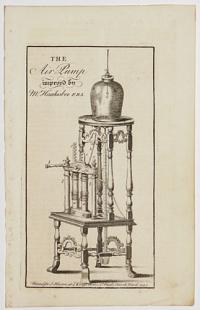
The Air Pump improved by Mr. Haukesbee F.R.S.
Printed for J. Hinton at ye Kings Arms, S.t Pauls Church Yard, 1747.
Enrgaving. Plate: 165 x 90mm (6½ x 3½") with large margins.
A diagram of an air pump designed by scientist Francis Hauksbee (1660-1713). The double barrelled pump was presented to the Royal Society in 1703.
[Ref: 46304] £75.00
(£90.00 incl.VAT)
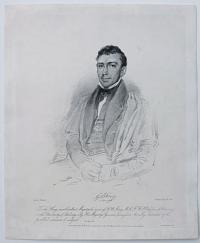
G. B. Airy. To the Kings most Excellent Majesty this print of G. B. Airy, M.A.F.R.S. Proffesor of Astronomy in the University of Cambridge is by His Majesty's Gracious permission humby dediated by his faithful servant & subject W. Mason.
Drawn by _ Wageman. On Stone by W. Slater. Printed by Graf & Soret. [n.d., c.1840.]
Published by W. Mason, Cambridge & by W. H. Mason
Rare lithograph. Sheet size: 370 x 305mm (14¼ x 12").
A rare portrait of George Biddell Airy (1801 - 1892), astronomer royal. Half length, seated, to the left, looking at the viewer with his hands together in his lap. In his role as Astronomer Royal between 1835 to 1881, Airy established Greenwich as the location of the prime meridian. His reputation has been tarnished by allegations that, through his inaction, Britain lost the opportunity of priority in the discovery of Neptune.
[Ref: 35776] £240.00
(£288.00 incl.VAT)
![G. B. Airy [facsimile signature].](img-thumbnail/jpegs/57109.jpg)
G. B. Airy [facsimile signature].
1852 T.H. Maguire.
Tinted lithograph. Printed area 330 x 240mm (13 x 9½"), very large margins.
A half-length portrait of George Biddell Airy (1801-92), seated, holding a device. During his tenure as Astronomer Royal (1835-1881) he established Greenwich as the location of the prime meridian.
[Ref: 57109] £320.00
(£384.00 incl.VAT)

S. Albertu' Clara fugat lampas noctem, liber otia tollit Mactatur Cypris flore, Cupido cruce
[after Hans von Aachen, as engraved by Robert Boissard.]
[n.d., c.1800.]
Engraving. 150 x 105mm (6 x 4"). Thread margin at bottom, tipped onto album sheet at corners.
A copy of a portrait of Saint Albertus Magnus (1200-80). [Albert Bullstredt] Albert was one of the Great Medieval Philosophers and scientists.
[Ref: 62686] £260.00
(£312.00 incl.VAT)
![[Der Gute Alchimyst wird nun den Barth Verbrennen, da er zum Schuld-Process die Feder Schneiden muss: Gold Macher!]](img-thumbnail/jpegs/66195.jpg)
[Der Gute Alchimyst wird nun den Barth Verbrennen, da er zum Schuld-Process die Feder Schneiden muss: Gold Macher!]
[by Valentin Daniel Priesler.]
[n.d., c.1760.]
Scarce mezzotint. Sheet 310 x 260mm (12¼ x 10¼"). Trimmed to image, losing title, creased.
The alchemist sits at a desk lit by a lamp, sharpening a quill.
[Ref: 66195] £260.00
(£312.00 incl.VAT)

"Wholemeal Bread" (D.r T.R. Allinson) "Vanity Fair" Supplement. Men of The Day. No. 1299.
Ray. Vincent Brooks, Day & Son, Lith.
[4th October 1911]
Chromolithograph, sheet 385 x 250mm (15¼ x 10"), large margins. Paper toned.
Full length caricature portrait of Thomas Richard Allinson (1858-1918) English physician, dietetic reformer, businessman, journalist and vegetarianism activist. He was a proponent of wholemeal bread consumption. His name is still used today for a bread popular in Europe, Allinson bread.
[Ref: 63671] £80.00
(£96.00 incl.VAT)
![[Headpiece?: animal dissection a the Acade´mie des sciences, Paris.]](img-thumbnail/jpegs/27669.jpg)
[Headpiece?: animal dissection a the Acade´mie des sciences, Paris.]
Le Clerc in. et fecit.
[Paris: Imprimerie royale?, n.d., c.1670s.]
Etching, illustration to a book, sheet/etched frame 100 x 245mm, 4 x 9¾". A fragment, with French letterpress to verso, rare. No margin outside border; staining upper right.
A wolf or fox's(?) internal organs are examined around a table by scientists; some consult charts and open books. Other learned figures conversing in groups behind, human and animal skeletons and skulls against the far wall. Possibly for Claude Perrault's 'Me´moires pour servir a l'histoire naturelle des animaux', the first important work on comparative anatomy. The frontispiece represents a meeting of the Acade´mie des sciences. The head and tail-pieces, plates and decorations were engraved by Sébastien Le Clerc (1637-1714). Le Clerc was a printmaker, draughtsman and military engineer who entered the Académie in 1672 and was later appointed professor of geometry and perspective. See Natural History Museum Zoology Library SHELVES 1 ff A.
[Ref: 27669] £260.00
(£312.00 incl.VAT)
![[François] Arago.](img-thumbnail/jpegs/30840.jpg)
[François] Arago.
Henri Sheffey pinx.t. Sixdeniers sculp.t.
A Paris chez l'Auteur, Rue Racine No 3, et chez Schroth, edit.r Rue Traversiere St Honoré 25.
Mezzotint, very scarce. 440 x 340mm (17¼ x 13¼). Slight scratch bottom right.
François Jean Dominique Arago (1786-1853), French mathematician, astronomer, whose recalculation of the Paris Meridian are commemorated by the 135 Arago medallions set into the ground through Paris. In the 1848 Revolution he joined the Provisional Government, in which he was responsible for abolishing flogging in the French Navy and then succeeded in procuring the abolition of slavery in the French colonies. In May he briefly served as Prime Minister of France, until the collective resignation of the Executive Power Commission in June. When Napoleon III took power in 1851 an oath of allegiance from all its functionaries, was required: Arago sent in his resignation as astronomer at the Bureau des Longitudes rather than take the oath, but Louis-Napoleon refused it and made "an exception in favour of a savant whose works had thrown lustre on France, and whose existence the government would regret to embitter." Wellcome: 90 Not in.
[Ref: 30840] £290.00
(£348.00 incl.VAT)

Archimède. Tiré du Cabinet de Monsieur Papillon de la Ferlé, Intendant et Contrôleur Général de l'Argenterie, Menus Plai=sirs et Affaires de la Chambre du Roi; et Trésorier Général de la Maison et Finances de M.gr le Comte de Provence & c.
Le Prince pin. R. Gaillard sculp.
A Paris et à Londres chez Tessari et C.º [n.d., c.1780.].
Rare etching, printed in red and brown. Sheet 355 x 260mm (14 x 10¼"). Trimmed within plate, repaired tear. Bit messy.
Archimedes, seen half-length, sitting at a desk, turned to left, and tracing figures with a pair of compasses; he wears a turban and an anachronistic embroidered gown. Archimedes (c.287-212BC) was a mathematician, born at Syracuse and died during the siege of the city. Le Prince's painting is a copy after Gerard Dou. First published by Gaillard c.1773.
[Ref: 66683] £180.00
(£216.00 incl.VAT)
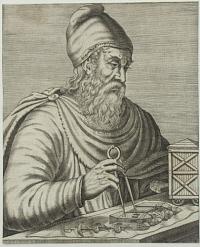
Archimedes Philosophe.
[n.d. c.1780.]
Copper engraving. Sheet 400 x 267mm. 15¾ x 10½".
Archimedes of Syracuse (287-212 BC) was a Greek mathematician, physicist, engineer, inventor and astronomer. He is seen as one of the leading scientists in classical antiquity. Through his studies he laid the foundations of hydrostatices, statics and an explanation of the principle of the lever. W: 96.
[Ref: 15644] £90.00
(£108.00 incl.VAT)

Baie De Sarah’s Bosom (Iles Auckland)
Dessiné par Le Breton. lith.par Sabatier. Imp par Lemercier.
Gide Editeur. [Paris, 1840-54.]
Lithograph with very large margins. Printed area 280 x 340mm (11 x 13¼"). Publisher's blind stamp.
The Astrolabe & Zélée anchored off the Auckland Islands, 300 miles south of South Island, New Zealand. For eight days in March 1840 the expedition's scientists explored the region, collecting bird, plant and rock samples. Their surgeon, Louis Le Breton, painted this scene From 'Voyage au pôle Sud et dans l'Océanie sur les corvettes l'Astrolabe et la Zélée 1837-1840', the account of Jules Dumont D'Urville's second expedition to the South Seas. The 31 volumes took 14 years to publish, not helped by D'Urville's death in the famous Versailles Rail Accident of 1842, the first French railway disaster.
[Ref: 35522] £190.00
(£228.00 incl.VAT)
![[A lecture on astronomy.]](img-thumbnail/jpegs/13718.jpg)
[A lecture on astronomy.]
Engrav'd for the Universal Magazine for J. Hinton, at the Kings Arms in St. Pauls Church Yard London, 1748.
Engraving, sheet 195 x 220mm. 7¾ x 8¾". Trimmed to image/title; two vertical folds (as normal).
Scientists in an interior surrounded by astronomical diagrams and globes. For the Universal Magazine.
[Ref: 13718] £95.00
(£114.00 incl.VAT)
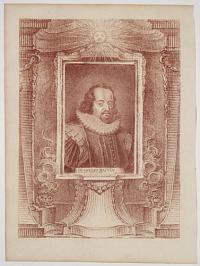
Francois Bacon. ne en 1561, mort en 1626.
[J. C. François.]
[Paris: Brunet, c.1760.]
Crayon manner, printed in red on watermarked laid paper, printed area 245 x 180mm. 9¾ x 7".
Francis Bacon, Viscount St Alban (1561 - 1626), was a lawyer, philosopher, essayist and scientist. Considered one the greatest intellectual figures of Jacobean England, he was appointed Lord Chancellor in 1618. After been impeached for bribery and confessing to 'corruption' and 'neglect' he took early retirement, and devoted himself to his scientific research. From Alexandre Savérien's 'Histoire des Philosophes modernes', published in eight 4to volumes from 1760-1767. 79 plates (and eight frontispieces) were engraved for the book. The plates engraved for vols 3-8 are adapted from a 12mo format, with the addition of a crayon manner border engraved by Jean Charles François (1717 - 1769), inventor of the technique in 1757. Wellcome 137 - not in.
[Ref: 22193] £190.00
(£228.00 incl.VAT)
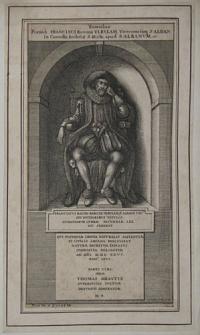
Tumulus Praenob: Francisci Baronis Verulam, Vicecomitisq, S.Alban in Cancello Ecclesiae S. Mich: apud S. Albanum. Franciscus Bacon Baro de Verulam Sti. Albani Vic.ntes Sev Notioribus Titulis Scientiarum Lumen, Eacundiae Lex Sic Sedebat. Qui Postquam Omnia Naturalis Sapientiae et Civilis Arcana Evolvisset Naturae, Decretum Explevit Composita Solvantur Ano. Dni. M.D.C. XXVI. Aetat.is LXVI. Tanti Viri Mem. Thomas Meatus Superstitus Cultor Defuncti Admirator. H.P.
Place this at ye end of ye life. W. Hollar fecit 1670.
Etching. Image 280 x 147mm. 11 x 5¾". Cut.
Francis Bacon, Viscount St Alban (1561-1626), was a lawyer, philosopher, essayist and scientist. Considered one the greatest intellectual figures of Jacobean England, he was appointed Lord Chancellor in 1618. After been impeached for bribery and confessing to 'corruption' and 'neglect' he took early retirement, devoting himself to his scientific research. Pennington 2243: iii of v.
[Ref: 14864] £220.00
(£264.00 incl.VAT)
![Walter Baker by Worlidge [ms]](img-thumbnail/jpegs/32864.jpg)
Walter Baker by Worlidge [ms]
[by Thomas Worlidge, c.1755]
Etching, platemark 200 x 155mm (8 x 6"). Fine impression; slight stains.
Portrait by Thomas Worlidge (1700-66), 'the English Rembrandt' and a pupil of Alessandro Maria Grimaldi, whose daughter Arabella he married. Lifetime impression before Worlidge's widow Mary issued new impressions in 1767 with number '61' added top right to correspond with the catalogue of his prints she produced. Dack reproduces an impression of this print with the following inscription in ms: 'This Portrait of Walter Baker (M.D. so created by himself) Painter, Designed & Etched by Thomas Worlidge Painter in the Little Piazza Covent Garden'. State i/ii; W61; D15; O'D incorrectly identifies this as a portrait of scientist Henry Baker, F.R.S.
[Ref: 32864] £260.00
(£312.00 incl.VAT)
![Robert Ball [facsimile signature].](img-thumbnail/jpegs/51182.jpg)
Robert Ball [facsimile signature].
T.H. Maguire.
M. & N. Hanhard Imp. [n.d., 1851.]
Lithograph on india. Printed area 375 x 280mm (14¾ x 11). Surface soiling.
Robert Ball (1802-57), Irish naturalist who served as the Director of the Dublin University Museum and inventor of 'Ball's Dredge', for the collection of marine organisms. Wellcome 159.
[Ref: 51182] £120.00
(£144.00 incl.VAT)
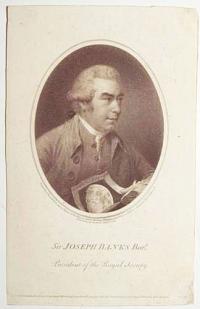
Sir Joseph Banks Bar.t President of the Royal Society.
Painted by J. Russell R.A. Crayon Painter to His Majesty, and to His Royal Highness the Prince of Wales_ Engraved by J. Collyer A._
Published as the Act directs May 16th 1789. Sold by W. Dickenson, Bond Stre. J. Cary, Strand, W. DArling, Newport Str. T. Simpson St Pauls Church Yard, and J. Collyer White Lion Row, Islington. Price 3s.
Stipple, sheet 175 x 110mm (7 x 4¼"). Trimmed within plate mark.
Sir Joseph Banks (1743-1820), English naturalist, botanist and patron of the natural sciences holding a 'Carte de la Lune par J. Russell' (map of the moon by J. Russell). Banks was leading founder of the African Association, a British organisation dedicated to the exploration of Africa, and a member of the Society of Dilettanti, which helped to establish the Royal Academy. He joined James Cook on his first voyage around the Pacific, and they came across New Zealand and Australia, where Cook mapped the coastline and made landfall at Botany Bay and at Endeavour River. Banks took a great interest in the British colonisation of the continent and was to be the greatest proponent of settlement of New South Wales. He was in fact the general advisor to the government on all Australian interests.
[Ref: 55263] £140.00
(£168.00 incl.VAT)
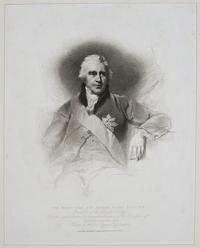
The Right Hon: Sir Joseph Banks, Bart, K.B. President of the Royal Society. From an original Picture by T. Lawrence, Esq. R.A. in the Possession of Samuel Lysons, Esq.
From an original Picture by T. Lawrence, Esq, R.A. in the Possession of Samuel Lysons Esq. Drawn by W. Evans, Engraved by A. Cardon.
Published Jan. 1. 1810 by T. Cadell & W. Davies, Strand London.
Stipple. 380 x 300mm (15 x 12"). Some foxing.
Half-length portrait of Joseph Banks (1743-1820) the famed naturalist and botanist, who found fame after an expedition to Labrador and Newfoundland and after accompanying James Cook on his first voyage around the Pacific. Banks held the position of President of The Royal Society for 41 and advised on the Royal Botanic Gardens at Kew. Banks is depicted wearing his star of the Order of the Bath, his hand resting on a book titled 'The Royal Society'.
[Ref: 35718] £220.00
(£264.00 incl.VAT)

The Right Honourable Sir Joseph Banks.K.B. President of the Royal Society.
Geo. Dance del. June 27,1803. W.m Daniell Fecit.
[Published by Will.m Daniell No.9 Cleveland Street, Fitzroy Square, London June 1, 1811.]
Soft ground etching. 270 x 200mm (10½" x 8") large margins. Margins bit messy.
Sir Joseph Banks, Bt, KCB, FRS. (1743-1820), naturalist who sailed with Cook on his first voyage to the Pacific, and subsequently esteemed patron of science and President of the Royal Society.
[Ref: 53834] £190.00
(£228.00 incl.VAT)
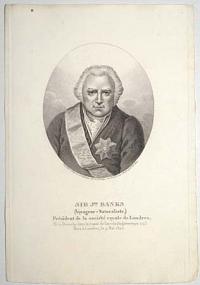
Sir J.ph Banks (Voyageur-Naturaliste,) Président de la société royale de Londres. Né à Revesby dans le Comté de Lincoln (Angleterre), en 1743. Mort à Londres, le 9 Mai 1820.
Dessiné d’après le Tableau de Th. Phillips, et Gravé par Ambroise Tardieu.
[n.d. c.1830.]
Stipple. 210 x 145mm (8¼ x 5¾"). Trimmed to plate top & bottom.
Sir Joseph Banks (1743-1820) the naturalist, botanist and explorer who was patron of science and President of the Royal Society, 1778-1820. He sailed with Captain Cook to the Pacific on his first voyage aboard the Endeavour, 1768-71, and compiled a unique natural history collection. He held a position of great influence in the scientific world and he advised on ventures such as the Kew Botanic Gardens and the first British colonies in Australia. W: 164 - not in. Kivell & Spence: pg.20.
[Ref: 54236] £120.00
(£144.00 incl.VAT)

Sir J. Banks. From a Picture by T. Phillips, in the Possession of the Royal Society. Under the Superintendence of the Society for the Diffusion of Useful Knowledge. Proof.
Engraved by C.E. Wagstaff.
London, Published by Charles Knight, Ludgate Street. [n.d. c.1835.]
Stipple, proof printed in chine collé. 290 x 205mm (11½ x 8").
Sir Joseph Banks, shown as President of the Royal Society. The original painting, by Thomas Phillips, is now in the National Portrait Gallery. Published in the ''The Gallery of Portraits: With Memoirs'', 1833-7.
[Ref: 52691] £130.00
(£156.00 incl.VAT)

Rt. Hon.ble Sr. Joseph Banks K.B. European Magazine.
Engraved by Ridley.
Pub by J Sewell Cornhill Oct 1 1802 [but later].
Stipple. 165 x 115mm (6½ x 4½").
Sir Joseph Banks (1743-1820), the English botanist, naturalist and patron of the natural sciences. Banks took part in Captain James Cook's first great voyage (1768-1771). He was the leading founder of the African Association, the British organization dedicated to the exploration of Africa, and a member of the Society of Dilettanti, which helped to establish the Royal Academy.
[Ref: 58704] £80.00
(£96.00 incl.VAT)

Peter Barlow Esqr. F.R.S. Acad. Imp. Sc. Petro. Amer. Art. et Sc. Socius. Inst. Nat. Sc. Paris. Acad. Reg. Sc. Brux. Corrsp. &c.
Painted by William Boxall, A.R.A. Engraved by Samuel Cousins, A.E. Subscribers Proof.
[n.d., c.1853.]
Mezzotint. Plate 454 x 354mm.
Peter Barlow, Mathematician and Physicist.[1776 -1862] wrote on pure and applied mathematics W: 174-3; BM 1889,1218.170.
[Ref: 1405] £280.00
(£336.00 incl.VAT)

Isaacus Barrow S.T.P. Reg. Ma.ti A Sacris coll. S.S. Trini. Cantab. Praefec. Nec-Non Acad. Eiusdem Procanc: 1676.
D. Loggan ad Vivum delin.
[n.d. c.1676.]
Engraving. 275 x 190mm. (10¾ x 7½"), with wide margins on 3 sides.
Portrait, head and shoulders in an oval frame, long hair, wearing bands, gown and robes; coat of arms below. Isaac Barrow (1630-1677) was a divine. He was an English theologian, and mathmatician who is generally remembered for his early role in the development of infinitesimal calculus, and particularly for the discovery of the fundamental theorem of calculus. Isaac Newton was a student of Barrow's and went on to develop calculus in a modern form. Wellcome Library no. 792i;
[Ref: 53621] £90.00
(£108.00 incl.VAT)

Isaacus Barrow S.T.P. Reg. Ma.ti A Sacris coll. S.S. Trini. Cantab. Praefec. Nec-Non Acad. Eiusdem Procanc: 1676.
D. Loggan ad Vivum delin.
[n.d. c.1676.]
Engraving. Platemark: 275 x 190mm (10¾ x 7½"), large margins.
Portrait of Isaac Barrow (1630-1677), head and shoulders in an oval frame, long hair, wearing bands, gown and robes, with a coat of arms below. Barrow was an English theologian and mathmatician who is generally remembered for his early role in the development of infinitesimal calculus, and particularly for the discovery of the fundamental theorem of calculus. Isaac Newton was a student of Barrow's and went on to develop calculus in a modern form. Wellcome Library no. 792i; ex Collection: R. Hobson of Hove.
[Ref: 39257] £140.00
(£168.00 incl.VAT)

William Barrowby, M.D.
F.Hayman Pinx.t. J.S.Müller sculp.t.
Sold by J.S.Müller at No 11 in Cravan Buildings ~ Price 2 Shill.ng.
A rare mezzotint. 350 x 250mm. Trimmed close to plate. Crease in top left corner.
It is said that this a portrait of the son of William Barrowby, Senior Fellow of the College of Physicians. The father cured Müller of a long illness, so Müller engraved this plate for free in gratitude. The painting by Hayman, although now untraced, is dated by Allen to the 1740s. CS: 1. Ex: Collection of The Hon. C. Lennox-Boyd; Brian Allen, 'Francis Hayman'
[Ref: 3110] £240.00
(£288.00 incl.VAT)

Jos de Beauchamp Astronomer.
Eng.d by Mackenzie from an Original Picture.
[n.d., c.1790.]
Stipple. Sheet 135 x 95mm (5¼ x 3¾"). Trimmed within plate and laid to album page; a strong impression.
Joseph de Beauchamp, astronomer, scientist, and papal assistant in 1782, in oriental costume, in an oval. Beauchamp explored Babylon and other archaeological sites by questioning nearby residents and watching excavations done by local peasants to salvage ancient fired bricks. He learned that ''by digging up the earth, they found a chamber that had a wall where a cow was formed from glazed bricks… which might shed some further light on the ancient religion of Chaldea''.
[Ref: 13890] £90.00
(£108.00 incl.VAT)

Claudius Berigardus Molinensis Philosophus et Medicus Aet. LI. Ellipsi minima Physici solertis imago Clauditur, aetbereo Mens nequit orbe capi.
Excudi curavit Joan. Jacobus Scharandeus Solodorensis. G. Georgi. Sc.
[n.d. c.1750.]
A scarce copper engraving. Plate 133 x 102mm. 5¼ x 4". Laid on album sheet.
Claude Beauregard (c.1591-1664) was a French physician and philosopher. He was professor at Pisa from 1628 until 1640, and from there he moved to Padua. His 'Circulus Pisnniis', published in 1643, was considered an Atheistic work. In the form of a dialogue he exhibited the various hypotheses of the formation of the world. The work was forbidden and is very rare. He was later charged for scepticism following the release of his book entitled 'Dubitutiones'.
[Ref: 16761] £95.00
(£114.00 incl.VAT)
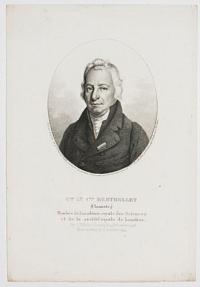
C.de L.is C.te Berthollet (Chimiste,) Membre de l’académie royale des Sciences et de la société royale de Londres. Né à Talloirse (Savoie) le 9 Décembre 1748. Mort à Paris le 6 Octobre 1822.
Dessiné d’apres un portrait a l’huille peint par un peintre Americain et communiqué par M.me Ve Berthollet et Gravé par Ambroise Tardieu.
[n.d. c.1830.]
Stipple. 214 x 145mm (8½ x 5¾"). Narrow margins.
Charles Louis Berthollet (1748-1822), the Savoyard-French chemist who later became vice president of the French Senate in 1804. He is known for his contributions to theory of chemical equilibria via the mechanism of reverse chemical reactions, and for his contribution to modern chemical nomenclature. He was also the first to demonstrate the bleaching action of chlorine gas, and the first to develop a solution of sodium hypochlorite as a modern bleaching agent. W: 271-4.
[Ref: 29584] £70.00
(£84.00 incl.VAT)

Frdr. Iustin Bertuch. Hrzgl. S. Weim. Legat. Rath. Geb.zu Weimar d.30 Sept. 1747. Stifter des Geograph. Instituts zu Weimar.
[illegible text.]
[German.] [n.d. c.1810.] 1808.
Stipple with large margins. Plate 129 x 87mm (5 x 3½"). Slight foxing and toning.
Friedrich Johann Justin Bertuch (1747-1822) the German publisher and patron of the arts. He was co-founder of the art and literature educational establishment in 1776, the Furstliche freie Zeichenschule Weimar. Publishers of maps. The portrait was published in 'Allgemeine Geographische Ephemeriden'
[Ref: 29730] £120.00
(£144.00 incl.VAT)
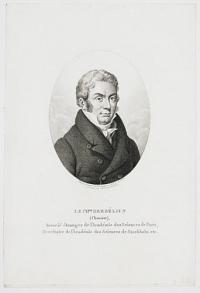
Le Ch.er Berzélius (Chimiste), Associé étranger de l’Académie des Sciences de Paris, Secrétaire de l’Académie des Sciences de Stockholm etc.
Dessiné d’apres le Buste que possède M. Dulong. Et Gravé par Ambroise Tardieu.
[n.d. c.1830.]
Stipple. 214 x 145mm (8½ x 5¾").
Jöns Jacob Berzelius (1779-1848), the Swedish chemist. He worked out the modern technique of chemical formula notation, and is together with John Dalton, Antonie Lavoisier, and Robert Boyle, considered a father of modern chemistry. He is known in Sweden as the father of Swedish Chemistry, and the 20 August is known as Berzelius Day. W: 275-2.
[Ref: 29585] £80.00
(£96.00 incl.VAT)
![[Dr Black Lecturing.]](img-thumbnail/jpegs/45299.jpg)
[Dr Black Lecturing.]
K Fec.t 1787. [John Kay.]
Etching. 110 x 90mm (4¼ x 9½"). Trimmed to plate.
A half-length portrait of Dr Joseph Black (1728-99), President of the Faculty of Physicians and Surgeons of Glasgow. He is holding his spectacles in his left hand and a letter in the right, and wears a dark gown and queue wig. On the table before him are papers, a wooden block, candle and a bird in a cage. Wellcome: 315-10.
[Ref: 45299] £95.00
(£114.00 incl.VAT)
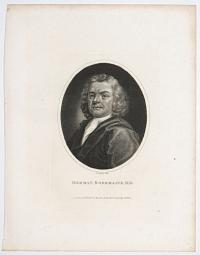
Herman Boerhaave, M.D.
J. Chapman sculp.
London, published as the Act directs Decr. 8. 1798 by J. Wilkes.
Stipple. Plate 165 x 115mm. 6½ x 4½".
Herman Boerhaave (1668-1738) the Dutch botanist, humanist and physician. He is regarded as the founder of clinical teaching and of the modern academic hospital. He was the first to isolate the chemical urea and urine. One of a number of stipple heads of Kings and Queens of similar format printed on quarto sheets, by Chapman, published by J. Wilkes, 1795-1810. They probably appeared as illustrations to the 'Encyclopaedia Londinensis, Universal Dictionary of Arts, Sciences and Literature ... Embellished by ... engravings. Compiled ... by John Wilkes'. W: 341-8.
[Ref: 27118] £70.00
(£84.00 incl.VAT)

Bonnet. This eminent naturalist was born at Geneva in 1720, in a family originally from France; but, disliking dry grammatical studies, his father provided him with a domestic tutor...Public honours were rendered to his remains by his fellow citizens, and his funeral eulogy was pronounced by his illustrious friend and kinsman M. de Saussure.
Holl sculp.t
[n.d. c.1800.]
Stipple with letterpress text underneath portrait. Sheet 246 x 152mm (9¾ x 6").
Charles Bonnet (1720-1793) the Swiss naturalist and philosophical writer, born at Geneva. Wellcome: 556 (not in).
[Ref: 28751] £45.00
(£54.00 incl.VAT)

Booker's Tower. Guilford. Erected 1839.
Sketched & Drawn on Stone by E.C. Duncumb. Printed by W. Clerk, 202 High Holborn.
Published by E. Andrews, 61 High St. Guilford.
Lithograph. Sheet: 280 x 225mm (11 x 9") very large margins.
A view of Booker's tower built by mayor of Guilford, Charles Booker in memory of his sons completed in 1839 it was used to commemorate the wedding of Queen Victoria and Prince Albert. It was also used by scientist John Rand Capron in his experiments with light.
[Ref: 43664] £120.00
(£144.00 incl.VAT)
![J..S. Bowerbank [facsimile signature].](img-thumbnail/jpegs/51185.jpg)
J..S. Bowerbank [facsimile signature].
T.H. Maguire.
M. & N. Hanhard Imp. [n.d., 1851.]
Lithograph on india. Printed area 350 x 240mm (13¾ x 9½").
James Scott Bowerbank (1797-1877) British naturalist and palaeontologist. The Palaeontographical Society was founded on his suggestion. Wellcome 396.
[Ref: 51185] £160.00
(£192.00 incl.VAT)
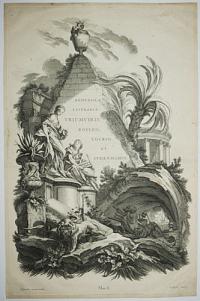
Reipublicae Literatiae Triumiris Boyleo, Lockio et Sydenhamio.
F. Boucher invenit et delin. Cl. Duflos Sculpsit.
Mac.S. [Paris: Basan, c.1737.]
Engraving. Plate: 650 x 410mm (25¾ x 16''). Small stain on right, central horizontal crease as normal. Small margins.
An allegorical monument to scientists and philosophers Thomas Sydenham (1624-1689), Robert Boyle (1627-1691) and John Locke (1632-1704). From Eugene Mac-Swiny's 'Tombeaux des Princes, Grand Capitaines et Autres Hommes Illustres, Qui ont fleuri dans la Grande-Bretagne'. Owen McSwiny, former manager of Drury Lane and the Haymarket Theatres, had travelled to Italy where he bought works of Italian painters, including Canaletto, to sell to English collectors. He also planned a series of historical pictures to decorate the Duke of Richmond's apartment at Goodwood, commemorating the deeds of famous Englishmen.
[Ref: 50887] £280.00
(£336.00 incl.VAT)

Tychonis Brahe
De L'armessin Sculp
From 'Academie des Science et des Arts', Amsterdam 1682.
Engraving. Sheet 185 x 135mm (7¼ x 5¼"). Trimmed to image and laid on album paper. Light staining across the image.
A half portrait of Tycho Brahe (1546-1601), a Dutch astronomer and nobleman. He observed that the moon orbited the Earth and that the planets orbited the Sun - although still believed the Sun orbited the Earth. He wore a prosthetic nose for much of his life after losing his original in a drunken duel with a cousin.
[Ref: 53793] £160.00
(£192.00 incl.VAT)
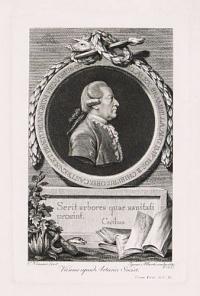
Io. Alex. Brambilla Aug. Imp: Ios: II. Chirurg: Ord: Castrens: Et Praetorianorum Primarius &c. Viennae apud Artaria Societ. Serit arbores quae sanitati prosint. Cecilius.
C. Vinazer fecit. Ignaz Alberti sculpsit &c. 1783.
Com Priv. S.C.M.
Engraving and stipple. Plate 165 x 107mm. 6½ x 4¼".
Johann Alexandre Brambilla (1729-1800) was an Italian physician and military surgeon. As a military surgeon he served during the Seven Years' War and then in 1764 he assumed the position of surgeon to Joseph II. In the National Library of Medicine. Wellcome Library: 1358i
[Ref: 23243] £75.00
(£90.00 incl.VAT)
![[Black man and woman from Bahia]](img-thumbnail/jpegs/45572.jpg)
[Black man and woman from Bahia] Nègre et nègresse de Bahia.
Dess d'ap nat. par Rugendas Lith. par Maurin
Lith. de Engelmann, rue du Faub Montmartre No.6 a Paris [1827-35]
Lithograph, printed area 320 x 245mm (12½ x 9½").
Man and woman from the state of Bahia in the north-east of Brazil. Plate from 'Voyage pittoresque au Brésil' (1827-35), a volume of lithographs after drawings by Johann Moritz Rugendas (1802-58). Rugendas, who came from a family including several notable artists, travelled to Brazil in 1821 as draughtsman with the Russian diplomat Baron de Langsdorff’s scientific expedition. However, Rugendas left the expedition, discovering Brazil for himself and returning to Europe in 1825 with the extraordinary collection of drawings which provided the material for 'Voyage pittoresque'. Encouraged by the German scientist and explorer Alexander von Humboldt, Rugendas returned to Latin America in 1831, living until 1845 in Mexico and Chile with shorter stays in Argentina, Peru, Bolivia, and Uruguay, and drawing and painting prolifically throughout this time. He returned to Bavaria, where nearly 3000 drawings and paintings were acquired by the local government, but he then went back to live in Brazil between 1845 and 1846.
[Ref: 45572] £320.00
![[Black women from Rio de Janeiro]](img-thumbnail/jpegs/45571.jpg)
[Black women from Rio de Janeiro] Nègresses de Rio-Janeiro
Dess d'ap nat. par Rugendas Lith. par Maurin
Lith. de Engelmann, rue du Faub Montmartre No.6 a Paris [1827-35]
Lithograph, printed area 320 x 240mm (12½ x 9½").
Plate from 'Voyage pittoresque au Brésil' (1827-35), a volume of lithographs after drawings by Johann Moritz Rugendas (1802-58). Rugendas, who came from a family including several notable artists, travelled to Brazil in 1821 as draughtsman with the Russian diplomat Baron de Langsdorff’s scientific expedition. However, Rugendas left the expedition, discovering Brazil for himself and returning to Europe in 1825 with the extraordinary collection of drawings which provided the material for 'Voyage pittoresque'. Encouraged by the German scientist and explorer Alexander von Humboldt, Rugendas returned to Latin America in 1831, living until 1845 in Mexico and Chile with shorter stays in Argentina, Peru, Bolivia, and Uruguay, and drawing and painting prolifically throughout this time. He returned to Bavaria, where nearly 3000 drawings and paintings were acquired by the local government, but he then went back to live in Brazil between 1845 and 1846.
[Ref: 45571] £320.00
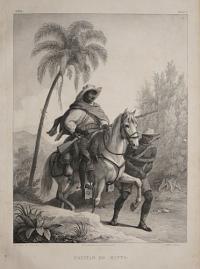
Capitao do matto
Dess d'ap nat. par Rugendas Lith. par Zwinger
Lith. de Engelmann, rue du Faub Montmartre No.6 a Paris [1827-35]
Lithograph, printed area 405 x 280mm (16 x 11").
A 'capitão do mato', an employee of a factory or plantation charged with recovering runaway slaves. Plate from 'Voyage pittoresque au Brésil' (1827-35), a volume of lithographs after drawings by Johann Moritz Rugendas (1802-58). Rugendas, who came from a family including several notable artists, travelled to Brazil in 1821 as draughtsman with the Russian diplomat Baron de Langsdorff’s scientific expedition. However, Rugendas left the expedition, discovering Brazil for himself and returning to Europe in 1825 with the extraordinary collection of drawings which provided the material for 'Voyage pittoresque'. Encouraged by the German scientist and explorer Alexander von Humboldt, Rugendas returned to Latin America in 1831, living until 1845 in Mexico and Chile with shorter stays in Argentina, Peru, Bolivia, and Uruguay, and drawing and painting prolifically throughout this time. He returned to Bavaria, where nearly 3000 drawings and paintings were acquired by the local government, but he then went back to live in Brazil between 1845 and 1846.
[Ref: 45578] £260.00
(£312.00 incl.VAT)
![[Corcovado mountain and the Catete neighbourhood, Rio de Janeiro]](img-thumbnail/jpegs/45557.jpg)
[Corcovado mountain and the Catete neighbourhood, Rio de Janeiro] Vue de la montagne de Corecovado et du faubourg de Cadete, prise de la Carrière
Dess d'ap nat. par Rugendas Deroi del.
Lith. de Engelmann, rue du faub Montmartre No.6 [1827-35]
Lithograph, printed area 280 x 365mm (11 x 14½").
View of mountains in Rio de Janeiro including Corcovado (now distinguished by the famous 'Christ the Redeemer' statue), with the neighbourhood of Catete in the middle-ground. Slaves working in a quarry in foreground. Plate from 'Voyage pittoresque au Brésil' (1827-35), a volume of lithographs after drawings by Johann Moritz Rugendas (1802-58). Rugendas, who came from a family including several notable artists, travelled to Brazil in 1821 as draughtsman with the Russian diplomat Baron de Langsdorff’s scientific expedition. However, Rugendas left the expedition, discovering Brazil for himself and returning to Europe in 1825 with the extraordinary collection of drawings which provided the material for 'Voyage pittoresque'. Encouraged by the German scientist and explorer Alexander von Humboldt, Rugendas returned to Latin America in 1831, living until 1845 in Mexico and Chile with shorter stays in Argentina, Peru, Bolivia, and Uruguay, and drawing and painting prolifically throughout this time. He returned to Bavaria, where nearly 3000 drawings and paintings were acquired by the local government, but he then went back to live in Brazil between 1845 and 1846.
[Ref: 45557] £260.00
(£312.00 incl.VAT)
![[Fields by the das Velhas river in the state of Minas Gerais, Brazil]](img-thumbnail/jpegs/45562.jpg)
[Fields by the das Velhas river in the state of Minas Gerais, Brazil] Campos sur les bords du rio das velhas. dans la province de Minaes Geraes.
Bonington del. fig. par V. Adam. dess d'ap nat. par Rugendas
Lith. de Engelmann, Rue Louis-le-Grand No 27 a Paris
Lithograph, printed area 285 x 345mm (11¼ x 13½").
Landscape in Minas Gerais, Brazil, with hunting in foreground. Plate from 'Voyage pittoresque au Brésil' (1827-35), a volume of lithographs after drawings by Johann Moritz Rugendas (1802-58). Rugendas, who came from a family including several notable artists, travelled to Brazil in 1821 as draughtsman with the Russian diplomat Baron de Langsdorff’s scientific expedition. However, Rugendas left the expedition, discovering Brazil for himself and returning to Europe in 1825 with the extraordinary collection of drawings which provided the material for 'Voyage pittoresque'. Encouraged by the German scientist and explorer Alexander von Humboldt, Rugendas returned to Latin America in 1831, living until 1845 in Mexico and Chile with shorter stays in Argentina, Peru, Bolivia, and Uruguay, and drawing and painting prolifically throughout this time. He returned to Bavaria, where nearly 3000 drawings and paintings were acquired by the local government, but he then went back to live in Brazil between 1845 and 1846. This particular plate is of added interest owing to the involvement of the landscape painter Richard Parkes Bonington (1802-28) as a draughtsman. Bonington lived in Paris for part of his short career, sharing a studio with Delacroix, and despite his death from tuberculosis at the age of 25, his work has consistently been held in high esteem.
[Ref: 45562] £280.00
(£336.00 incl.VAT)
![[Inhomirim river in the state of Rio de Janeiro]](img-thumbnail/jpegs/45563.jpg)
[Inhomirim river in the state of Rio de Janeiro] Rio Jnhomerim, dans la Baie de Rio de Janeiro
Villeneuve del. fig. par V. Adam. dess d'ap nat. par Rugendas
Lith. de Engelmann, Rue Louis-le-Grand No 27 a Paris
Lithograph, printed area 295 x 340mm (11¾ x 13½").
Landscape in the state of Rio de Janeiro, with hunters shooting crocodile in foreground. Plate from 'Voyage pittoresque au Brésil' (1827-35), a volume of lithographs after drawings by Johann Moritz Rugendas (1802-58). Rugendas, who came from a family including several notable artists, travelled to Brazil in 1821 as draughtsman with the Russian diplomat Baron de Langsdorff’s scientific expedition. However, Rugendas left the expedition, discovering Brazil for himself and returning to Europe in 1825 with the extraordinary collection of drawings which provided the material for 'Voyage pittoresque'. Encouraged by the German scientist and explorer Alexander von Humboldt, Rugendas returned to Latin America in 1831, living until 1845 in Mexico and Chile with shorter stays in Argentina, Peru, Bolivia, and Uruguay, and drawing and painting prolifically throughout this time. He returned to Bavaria, where nearly 3000 drawings and paintings were acquired by the local government, but he then went back to live in Brazil between 1845 and 1846. This particular plate is of added interest owing to the involvement of the landscape painter Richard Parkes Bonington (1802-28) as a draughtsman. Bonington lived in Paris for part of his short career, sharing a studio with Delacroix, and despite his death from tuberculosis at the age of 25, his work has consistently been held in high esteem.
[Ref: 45563] £320.00
![[View taken from the Monastery of St Benedict, Rio de Janeiro]](img-thumbnail/jpegs/45553.jpg)
[View taken from the Monastery of St Benedict, Rio de Janeiro] Vue prise devant l'élise de San-Bendo à Rio Janeiro
V. Adam del.t Dess d'ap nat. par Rugendas
Lith. de Engelmann, rue du F. Montmartre No.6 [1827-35]
Lithograph, printed area 250 x 320mm (9¾ x 12½").
View showing the Rio de Janeiro coastline, taken from the Mosteiro de São Bento (Monastery of St Benedict). Plate from 'Voyage pittoresque au Brésil' (1827-35), a volume of lithographs after drawings by Johann Moritz Rugendas (1802-58). Rugendas, who came from a family including several notable artists, travelled to Brazil in 1821 as draughtsman with the Russian diplomat Baron de Langsdorff’s scientific expedition. However, Rugendas left the expedition, discovering Brazil for himself and returning to Europe in 1825 with the extraordinary collection of drawings which provided the material for 'Voyage pittoresque'. Encouraged by the German scientist and explorer Alexander von Humboldt, Rugendas returned to Latin America in 1831, living until 1845 in Mexico and Chile with shorter stays in Argentina, Peru, Bolivia, and Uruguay, and drawing and painting prolifically throughout this time. He returned to Bavaria, where nearly 3000 drawings and paintings were acquired by the local government, but he then went back to live in Brazil between 1845 and 1846.
[Ref: 45553] £230.00
(£276.00 incl.VAT)

Porto do Estrella.
Dess d'ap nat. par Rugendas V. Adam del.
Lith. de Engelmann, rue du F. Montmartre No.6 [n.d., 1827-35]
Lithograph. Sheet 270 x 335mm. Trimmed into image on three sides.
A view on the quay of Porto Estrela, with boats being loaded from a mule train. From 'Voyage pittoresque au Brésil' (1827-35), a volume of lithographs after drawings by Johann Moritz Rugendas (1802-58). Rugendas, who came from a family including several notable artists, travelled to Brazil in 1821 as draughtsman with the Russian diplomat Baron de Langsdorff's scientific expedition. However, Rugendas left the expedition, discovering Brazil for himself and returning to Europe in 1825 with the extraordinary collection of drawings which provided the material for 'Voyage pittoresque'. Encouraged by the German scientist and explorer Alexander von Humboldt, Rugendas returned to Latin America in 1831, living until 1845 in Mexico and Chile with shorter stays in Argentina, Peru, Bolivia, and Uruguay, and drawing and painting prolifically throughout this time. He returned to Bavaria, where nearly 3000 drawings and paintings were acquired by the local government, but he then went back to live in Brazil between 1845 and 1846.
[Ref: 63339] £240.00
(£288.00 incl.VAT)
![[Military and slaves on boats, Rio de Janeiro coastline]](img-thumbnail/jpegs/45554.jpg)
[Military and slaves on boats, Rio de Janeiro coastline] Braia dos Mineiros à Rio-Janeiro
V. Adam del.t Dess d'ap nat. par Rugendas
Lith. de Engelmann, rue du F. Montmartre No.6 [1827-35]
Lithograph, printed area 260 x 330mm (10¼ x 13").
Stretch of Rio de Janeiro coastline formerly known as the 'Praia dos Mineiros'. Plate from 'Voyage pittoresque au Brésil' (1827-35), a volume of lithographs after drawings by Johann Moritz Rugendas (1802-58). Rugendas, who came from a family including several notable artists, travelled to Brazil in 1821 as draughtsman with the Russian diplomat Baron de Langsdorff’s scientific expedition. However, Rugendas left the expedition, discovering Brazil for himself and returning to Europe in 1825 with the extraordinary collection of drawings which provided the material for 'Voyage pittoresque'. Encouraged by the German scientist and explorer Alexander von Humboldt, Rugendas returned to Latin America in 1831, living until 1845 in Mexico and Chile with shorter stays in Argentina, Peru, Bolivia, and Uruguay, and drawing and painting prolifically throughout this time. He returned to Bavaria, where nearly 3000 drawings and paintings were acquired by the local government, but he then went back to live in Brazil between 1845 and 1846.
[Ref: 45554] £230.00
(£276.00 incl.VAT)




![G. B. Airy [facsimile signature].](img-thumbnail/jpegs/57109.jpg)

![[Der Gute Alchimyst wird nun den Barth Verbrennen, da er zum Schuld-Process die Feder Schneiden muss: Gold Macher!]](img-thumbnail/jpegs/66195.jpg)

![[Headpiece?: animal dissection a the Acade´mie des sciences, Paris.]](img-thumbnail/jpegs/27669.jpg)
![[François] Arago.](img-thumbnail/jpegs/30840.jpg)



![[A lecture on astronomy.]](img-thumbnail/jpegs/13718.jpg)


![Walter Baker by Worlidge [ms]](img-thumbnail/jpegs/32864.jpg)
![Robert Ball [facsimile signature].](img-thumbnail/jpegs/51182.jpg)















![[Dr Black Lecturing.]](img-thumbnail/jpegs/45299.jpg)



![J..S. Bowerbank [facsimile signature].](img-thumbnail/jpegs/51185.jpg)



![[Black man and woman from Bahia]](img-thumbnail/jpegs/45572.jpg)
![[Black women from Rio de Janeiro]](img-thumbnail/jpegs/45571.jpg)

![[Corcovado mountain and the Catete neighbourhood, Rio de Janeiro]](img-thumbnail/jpegs/45557.jpg)
![[Fields by the das Velhas river in the state of Minas Gerais, Brazil]](img-thumbnail/jpegs/45562.jpg)
![[Inhomirim river in the state of Rio de Janeiro]](img-thumbnail/jpegs/45563.jpg)
![[View taken from the Monastery of St Benedict, Rio de Janeiro]](img-thumbnail/jpegs/45553.jpg)

![[Military and slaves on boats, Rio de Janeiro coastline]](img-thumbnail/jpegs/45554.jpg)